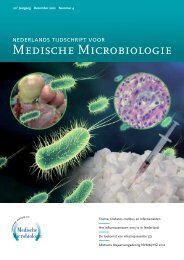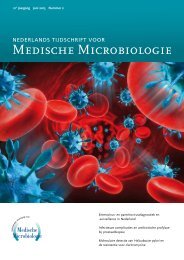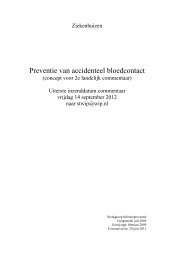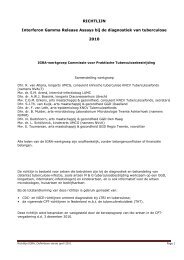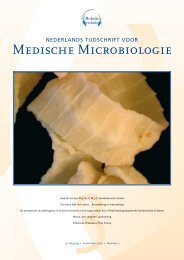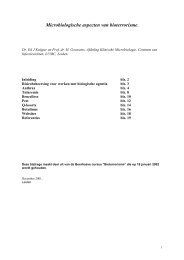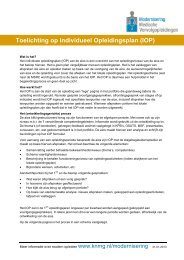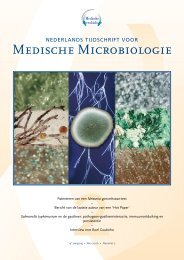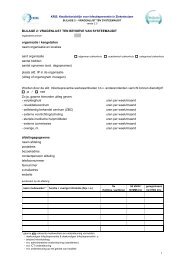Supplement bij veertiende jaargang, april 2006 - NVMM
Supplement bij veertiende jaargang, april 2006 - NVMM
Supplement bij veertiende jaargang, april 2006 - NVMM
Create successful ePaper yourself
Turn your PDF publications into a flip-book with our unique Google optimized e-Paper software.
eduction, was applied. The DGGE profiles showed a<br />
relatively high SRB diversity and similar profiles for<br />
lakes with similar salinity and pH. Individual DGGE<br />
bands were sequenced and phylogenetic analysis was<br />
performed. Firstly, the closest relatives were determined<br />
using the BLAST search tool, subsequently the sequences<br />
were imported into the ARB software program, manually<br />
aligned and added into an existing tree. All our sequences<br />
grouped with those from Deltaproteobacteria and in<br />
particular with sequences of Desulfonatronum hydrogenovorans<br />
and Desulfonatronum lacustre, two low salt-tolerant<br />
alkaliphilic sulfate reducers isolated from soda lakes.<br />
These results give for the first time insight in an important<br />
functional group of microorganisms in soda lakes, which<br />
is essential for a better understanding of the sulfur cycle<br />
in these ecosystems.<br />
06.14<br />
Metabolic engineering of folate biosynthesis in Lactobacillus<br />
plantarum<br />
A. Wegkamp1,3 , B. Teusink 1,2,3 , A. Mars1,3 , J. Hugenholtz1,3 ,<br />
W.M. de Vos1 , E.J. Smid1,2,3 1 2 Wageningen Centre for Food Sciences, Wageningen, NIZO<br />
Food Research, Ede, 3Kluyver Centre for Genomics of Industrial<br />
Fermentation, Delft<br />
Many plants and micro-organisms have the ability to<br />
synthesise folate, whereas animals lack this ability. Folate<br />
is an essential cofactor for the synthesis of DNA, RNA<br />
and certain amino acids. Folate-deficiency in humans<br />
is often associated with anaemia, neural tube defects<br />
and cardiovascular diseases. A number of folate related<br />
deficiencies in humans can be overcome by uplifting<br />
the folate consumption levels. One way of doing this is<br />
to produce fermented food products with elevated folate<br />
levels. As an alternative for traditional fortification, this<br />
could be achieved by using folate (over)producing lactic<br />
acid bacteria in the fermentation process.<br />
Here we present a metabolic engineering strategy that<br />
yields a Lactobacillus plantarum strain producing elevated<br />
folate pools. The genes involved in folate biosynthesis in<br />
L. plantarum were identified and cloned on a vector and<br />
subsequently transferred to the host strain L. plantarum<br />
WCFS1. The transformed L. plantarum strains were found<br />
to produce high folate levels (10 mg/l) upon the supplementation<br />
of para-aminobenzoic acid (a building block in<br />
the folate biosynthesis). In the folate overproducing strain<br />
the transcriptome and metabolome were compared to that<br />
of the wild type using DNA-microarrays and deferential<br />
LC-MS, respectively. The transcriptome and metabolome<br />
data will subsequently be projected on metabolic pathway<br />
maps specifically designed for L. plantarum WCFS1. The<br />
transcription profiling coupled with the metabolic map<br />
Ned Tijdschr Med Microbiol <strong>2006</strong>; 4:<strong>Supplement</strong><br />
S37<br />
will facilitate the formulation of improved metabolic<br />
engineering strategies to further increase folate levels in<br />
the host strain. In addition, this approach will lead to a<br />
better understanding of regulatory aspects of folate biosynthesis<br />
in L. plantarum.<br />
06.15<br />
Measuring yeasts intracellular pH upon sorbic acid stress<br />
in vivo<br />
R. Orij, J. Postmus, S. Brul, G. Smits<br />
Swammerdam Institute for Life Sciences (SILS), Molecular<br />
Biology & Microbial Food Safety, Amsterdam<br />
Sorbic acid, a weak organic, is the most widespread food<br />
preservative used in the industry. Yeast and other fungi<br />
are, to a certain extent, able adapt to this acid and resume<br />
growth in the presence of the highest concentrations<br />
allowed in foods. This can result in product spoilage and<br />
thus create substantial economic losses. Quite a lot is<br />
known with respect to the end point of the yeasts’ response<br />
to sorbic acid stress, i.e. when growth is resumed, from<br />
genome-wide transcript analyses and studies with yeast<br />
knockout mutants. However currently we still do not<br />
know why the cells initially arrest growth upon the weakacid<br />
challenge. Also the molecular physiological events<br />
that occur during the adaptation phase and finally lead<br />
to a resumption of growth are poorly understood. Thus,<br />
to understand the mechanisms of growth limitation and<br />
adaptation we perform time-resolved studies of yeast cells<br />
exposed to sorbic acid in an integrated way. That is, we<br />
perform analyses at the level of gene expression, protein<br />
composition, and cellular metabolism. By calculating<br />
energy generating capacity, we try to map the cost and<br />
benefit of the various aspects of the stress response<br />
towards weak acids. In practice this means we determine<br />
metabolic fluxes, ATP/ADP ratios and ultimately try to<br />
construct a mathematical model of the response to the<br />
stress. Currently we are working on an experiment to<br />
measure intracellular pH upon sorbate stress in vivo. We<br />
use a pH sensitive GFP originally developed in mammals<br />
called a ‘pHluorin’ (Miesenböck et al., 1998). This GFP has<br />
been constructed in such a way that it can monitor the pH<br />
of its environment without disturbing cell function. We<br />
targeted this GFP to different compartments of the cell<br />
using different targeting sequences. The first results show<br />
that the system works in yeast and online pH measurements<br />
without applying a stress are possible.




